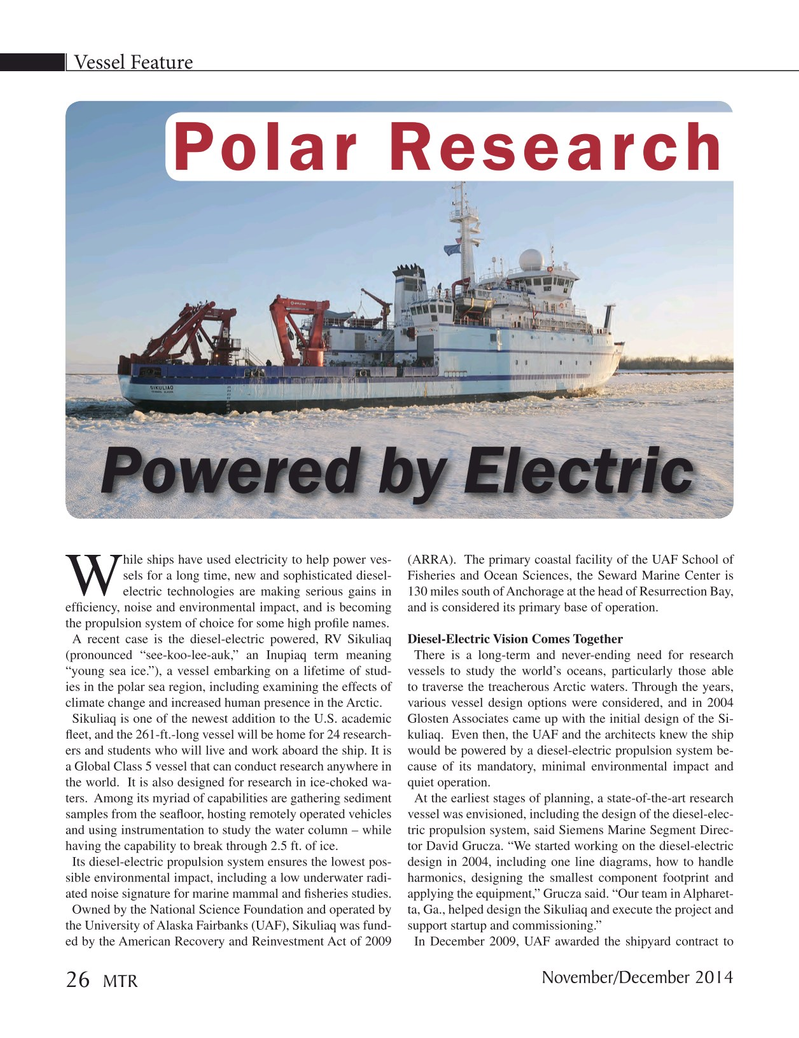
Page 26: of Marine Technology Magazine (November 2014)
Fresh Water Monitoring & Senors
Read this page in Pdf, Flash or Html5 edition of November 2014 Marine Technology Magazine
Vessel Feature
Polar Research
Powered by Electric hile ships have used electricity to help power ves- (ARRA). The primary coastal facility of the UAF School of sels for a long time, new and sophisticated diesel- Fisheries and Ocean Sciences, the Seward Marine Center is
Welectric technologies are making serious gains in 130 miles south of Anchorage at the head of Resurrection Bay, ef? ciency, noise and environmental impact, and is becoming and is considered its primary base of operation.
the propulsion system of choice for some high pro? le names.
A recent case is the diesel-electric powered, RV Sikuliaq Diesel-Electric Vision Comes Together (pronounced “see-koo-lee-auk,” an Inupiaq term meaning There is a long-term and never-ending need for research “young sea ice.”), a vessel embarking on a lifetime of stud- vessels to study the world’s oceans, particularly those able ies in the polar sea region, including examining the effects of to traverse the treacherous Arctic waters. Through the years, climate change and increased human presence in the Arctic. various vessel design options were considered, and in 2004
Sikuliaq is one of the newest addition to the U.S. academic Glosten Associates came up with the initial design of the Si- ? eet, and the 261-ft.-long vessel will be home for 24 research- kuliaq. Even then, the UAF and the architects knew the ship ers and students who will live and work aboard the ship. It is would be powered by a diesel-electric propulsion system be- a Global Class 5 vessel that can conduct research anywhere in cause of its mandatory, minimal environmental impact and the world. It is also designed for research in ice-choked wa- quiet operation. ters. Among its myriad of capabilities are gathering sediment At the earliest stages of planning, a state-of-the-art research samples from the sea? oor, hosting remotely operated vehicles vessel was envisioned, including the design of the diesel-elec- and using instrumentation to study the water column – while tric propulsion system, said Siemens Marine Segment Direc- having the capability to break through 2.5 ft. of ice. tor David Grucza. “We started working on the diesel-electric
Its diesel-electric propulsion system ensures the lowest pos- design in 2004, including one line diagrams, how to handle sible environmental impact, including a low underwater radi- harmonics, designing the smallest component footprint and ated noise signature for marine mammal and ? sheries studies. applying the equipment,” Grucza said. “Our team in Alpharet-
Owned by the National Science Foundation and operated by ta, Ga., helped design the Sikuliaq and execute the project and the University of Alaska Fairbanks (UAF), Sikuliaq was fund- support startup and commissioning.” ed by the American Recovery and Reinvestment Act of 2009 In December 2009, UAF awarded the shipyard contract to
November/December 2014 26 MTR
MTR #9 (18-33).indd 26 MTR #9 (18-33).indd 26 12/9/2014 11:45:57 AM12/9/2014 11:45:57 AM

 25
25

 27
27
